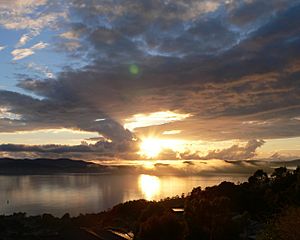Derwent River facts for kids
Quick facts for kids Derwent River |
|
| River | |
|
Sunrise over the Derwent River
|
|
| Country | Australia |
|---|---|
| State | Tasmania |
| Tributaries | |
| - left | Ouse River, Jordan River |
| Cities | Derwent Bridge, New Norfolk, Bridgewater, Hobart |
| Source | Lake St Clair |
| - location | Cradle Mountain-Lake St Clair National Park, Central Highlands, Tasmania, Australia |
| - elevation | 1,545 m (5,069 ft) |
| - coordinates | 42°7′12″S 146°12′37″E / 42.12000°S 146.21028°E |
| Mouth | Storm Bay |
| - location | Storm Bay, Hobart, Tasmania, Australia |
| - elevation | 0 m (0 ft) |
| - coordinates | 43°3′3″S 147°22′38″E / 43.05083°S 147.37722°E |
| Length | 239 km (149 mi) |
| Basin | 9,832 km² (3,796 sq mi) |
| Discharge | for Storm Bay |
| - average | 90 m³/s (3,178 cu ft/s) |
| - max | 140 m³/s (4,944 cu ft/s) |
| - min | 50 m³/s (1,766 cu ft/s) |
The Derwent River is an important river in Tasmania, Australia. It flows for about 239 kilometers (149 miles). This makes it one of the longest rivers in Tasmania.
The river got its name from a similar river in England. British explorer John Hayes named it in 1793. The name "Derwent" comes from an old Celtic language. It means "valley thick with oaks." At first, Hayes only named the upper part of the river. Later, another explorer, Matthew Flinders, used the name for the entire river.
Contents
Discover the Derwent River
The Derwent River starts high up in the mountains. Its source is Lake St Clair. This lake is found in the beautiful Cradle Mountain-Lake St Clair National Park. The river then flows southeast. It passes through many towns and cities. These include Derwent Bridge and New Norfolk. Finally, it reaches the capital city of Hobart. Here, the river empties into Storm Bay. This bay is part of the ocean.
What is the Derwent River Like?
The Derwent River is a big river. Its watershed covers a huge area. This means all the land that drains water into the river. The Derwent's watershed is about 9,832 square kilometers (3,796 square miles). This is a very large area. The river carries a lot of water. On average, about 90 cubic meters of water flow out every second. This amount can change a lot. It depends on how much rain falls.
Rivers Joining the Derwent
Many smaller rivers flow into the Derwent. These are called tributaries. Some of the main ones include the Ouse River and the Jordan River. These rivers add more water to the Derwent. They help make it such a powerful waterway.
History of the Derwent River Area
Long ago, the areas along the Derwent River were covered in thick forests. Aboriginal people lived here for thousands of years. They used the river for food and travel. They had a deep connection to the land.
European Settlers and Changes
Later, European settlers arrived in Tasmania. They started farms along the river banks. They cleared some of the forests. During the 1900s, many dams were built. These dams were placed on the Derwent's tributaries. They helped control the water flow. They also provided power for homes and industries.
Images for kids
-
Derwent river as seen from Poimenna Reserve, Austins Ferry


